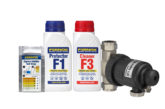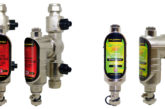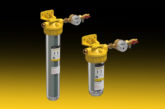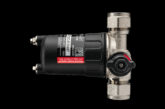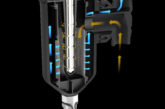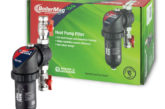
Ed Morris, Technical Manager at Altecnic, details the key facts of water treatment, looking at BS 7593:2019 standards, the causes of common problems and how to treat water.
What is BS 7593:2019?
BS 7593:2019 sets out recommendations on good practice for preparation of the water within both open vented and sealed heating or cooling systems in individual domestic premises.
It outlines initial commissioning or recommissioning following major remedial works such as boiler replacement, but also ongoing water treatment to ensure system protection and efficiency.
What are the objectives of system water treatment?
- To minimise corrosion of the system metals
- To inhibit the formation of scale and sludge
- To inhibit the growth of microbiological organisms
- To maintain the engineering design specification and efficiency of the system
- To restore energy efficiency of the system where appropriate
Causes of corrosion
Corrosion is generally a process of oxidation of metals which, in a central heating system, can result in restriction of circulation and/or failure of components, for example – perforation of radiators. Corrosion in a central heating system is promoted by the following:
- Poor system design and/or installation by creating oxygenated water
- Ingress of air e.g. mechanical or poorly soldered joints
- Electrolytic (galvanic) action between dissimilar metals
- Deleterious materials, e.g. flux residues or jointing compound from the installation process
- Characteristics of the supply water (hard or soft water) and also chlorine content that can promote pitting of ferrous and non-ferrous metals
- Other sources of chloride, which include fluxes, hydrochloric acid and washing materials
- Presence of anaerobic bacteria resulting in acidity and localised pitting corrosion
- Incorrect, unsuitable or poorly applied or maintained water treatment products
- The formation of corrosion products deposited or plated out in the system
Causes of scale & sludge
“Hardness” is the term which describes the concentration of calcium and magnesium salts dissolved in water, usually expressed as calcium carbonate (CaCO3) equivalence (scale).
System areas most prone to failure due to fouling by scale or sludge include the boiler heat exchanger and circulator pump.
Fouling can also restrict flow through components such as thermostatic radiator valves, zone valves, drain valves, etc., and any parts of the system where there is a low water velocity or small pipe diameters (e.g. in radiators or fan convectors and microbore circuits).
Sludge accumulation will result in poor circulation and a decrease in system efficiency.
Causes of microbiological contamination
Microbiological organisms ranging from simple bacteria to fungal and yeast spores can cause problems when they enter a central heating system.
The greatest potential for microbiological proliferation exists in the feed and expansion cistern of open-vented systems. Here the temperature conditions are more favourable for bacterial growth and there is contact with the air.
Under-floor heating and other systems which operate at lower temperature (below 60 °C) can also be prone to microbiological fouling. Even the high temperature in the boiler heat exchanger might not be sufficient to kill all micro-organisms.
Anaerobic bacteria can thrive in both open and sealed systems fouled with corrosion and other debris, beneath deposits where the temperature might be lower and there is an absence of oxygen. This can give rise to microbiological corrosion of ferrous metals.
How do you treat water?
General Treatment: In most cases, the quality of the water used in the central heating system is determined by supply to the premises and this will vary across the United Kingdom.
Water treatment should be applied to all primary systems except for single feed indirect hot water cylinders.
Consideration should be given as to whether the water is hard or soft, as this might influence the approach to water treatment and the choice of proprietary product.
External Treatment: Naturally soft waters of low alkalinity or those supplied via a base-exchange resin softener have an increased potential for corrosion and, if they are to be used in any central heating system, a corrosion inhibitor specifically formulated for the purpose should be added and properly maintained.
Internal Treatment: To minimize the likelihood of corrosion, scale and sludge formation, the system water in any system should be treated with Altecnic C1 System Inhibitor, prior to this the system should be treated using Altecnic C3 System Clean to remove all system impurities as discussed above.
Bioocides may be dosed into static systems to prevent bacteria multiplying when there is a delay between pressure testing and commencement of flushing and chemical cleaning.
System flushing
Cleaning and flushing should be undertaken prior to commissioning a new system and during refurbishment or repair of a system to overcome its loss of effectiveness and efficiency caused by the effects of poor water quality.
Where a system has been filled for a long period prior to commissioning addition of a biocide, circulation (refer to manufacturer’s instructions) followed by a flush might be required in order to remove biofilm.
Cleaning and flushing should be undertaken to remove adherent and settled foulants and debris, and suspended sludge from systems.
Where a system is heavily fouled, a pre-flush should be considered prior to the cleaning cycle. The effectiveness of the cleaning cycle is determined by correct choice and application of the cleaning chemical – a good cleaning chemical should dissolve and/or disperse sludge and contaminants.
Altecnic provides a range of dirt and air separators, such as the Dirtmag Mini, and new Caleffi XS and Caleffi XF, that offer ongoing system protection through their designs and also allow easy maintenance to ensure that a system remains clean.
Main Image: Ed Morris, Technical Manager at Altecnic, details the key facts of water treatment




